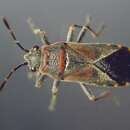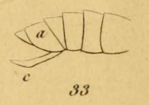ar
الأسماء في صفحات التنقل


Arocatus melanocephalus, the elm seed bug, is a true bug in the family Lygaeidae. The species was initially described by Johan Christian Fabricius in 1798, and Maximilian Spinola designated it to be the type species of the genus Arocatus in 1837. This bug is native to Europe but has been introduced to North America.

The Danish zoologist Johan Christian Fabricius named this species in 1798, placing it in the genus Lygaeus.[2] When the Italian entomologist Maximilian Spinola named the genus Arocatus in 1837, he designated Fabricius's Lygaeus melanocephalus as its type species.[3] In 1999, Jean Péricart designated a female lectotype in the University of Copenhagen Zoological Museum.[4]
Lygaeus pruinosus, a nomen nudum referring to this species, was named by Eduard Friedrich Eversmann in 1837.[4][5] Vasily Evgrafovich Yakovlev synonymized this name with A. melanocephalus in 1875.[6][7] The French entomologist Charles Jean-Baptiste Amyot referred to this species as Arocatus using his system of uninonial nomenclature[8] in a work later invalidated by the International Commission on Zoological Nomenclature.[9]
As of 2017, three subspecies are recognized: the nominate subspecies A. m. melanocephalus, A. m. austerus, and A. m. melandiscus.[10] Amyot gave the mononym Melandiscus for a specimen which Vittore Ghiliani had collected in Piedmont.[8] In 1869, the Italian entomologist Antonio Garbiglietti designated Amyot's melandiscus as a variety of A. melanocephalus.[11] This subspecies is found in Italy.[12] The subspecies A. m. austerus was named by the German entomologist Wolfgang Stichel in 1957.[13]
A. melanocephalus
Maximum-likelihood tree of some Arocatus species. Star denotes when the ability to sequester cardenolides was lost.[14]A. melanocephalus, unlike many Lygaeinae species, only stored less than 7% of the cardenolides [3H]-ouabain or [3H]-digoxin ten days after being fed these substances.[14] A 2015 phylogenetic study of the subfamily Lygaeinae included four species of the genus Arocatus: A. aenescens, A. rusticus, A. rusticus, and A. melanocephalus; it placed A. melanocephalus in a clade with A. longiceps — the other Arocatus which could not store cardenolides.[14]
It has been found on Ulmus (elm) species, Platanus orientalis (old world sycamore),[4] Populus (poplar) species, as well as inside empty butterfly pupa covers.[15] It has also been recorded on Quercus (oak) and Alnus (alder) species.[16]
Adults produce a strong, unpleasant smell which is reminiscent of bitter almonds.[17] The scent glands' openings are on the metathorax, between the second and third pairs of legs.[18]
The body is dark red in color, and it is covered in short hairs. The head is black, and antennae are also mostly black, although on occasion the III and IV segments are partly red. The pronotum has a M-shaped spot.[4] The underbelly is orange, and adults measure 0.33 in (8.4 mm) in length.[19]
Within Europe, it has been found in the countries Andorra, Austria, Belgium, Bosnia & Herzebovina, Bulgaria, Croatia, Czech Republic, France, Germany, Greece, Hungary, Italy, Moldova, Montenegro, the Netherlands,[21] Poland, Portugal, Romania, Russia, Serbia, Slovakia,[16] Slovenia, Spain, Switzerland, and Ukraine.[4] However many of these central European records are quite old, dating to the late 19th and early 20th centuries; it is thought they had become rarer in Europe in the late 20th century due to Dutch elm disease killing many European elms.[22]
Starting in 1999, A. melanocephalus has infested buildings in northern Italian cities, particularly in the regions of Emilia Romagna, Veneto, and Friuli-Venezia Giulia.[17] These infestations occur in the summer, starting in late May or early June and ending in late September.[17] Some Italian researchers believe this might be due to global warming, and that the insects enter buildings to escape the summer heat.[17] The population increased in Turin in 2007, despite an increase in chemical insecticides; etofenprox is effective against this species but pyrethrum and rotenone were not.[23] Mass occurrences also increased in Germany in the early 21st century.[24]
In Asia, it has been found in Armenia, Azerbaijan, Georgia, Turkey, China,[4] and Iran.[25] They have been recorded inside buildings in Yining, Xinjiang, China.[4]
In North America, A. melanocephalus have been found in the Canadian province of British Columbia,[26] and the American states of Washington, Oregon, Idaho,[19] Michigan,[27] Utah,[28] and Colorado.[29] It was introduced to the Nearctic realm in the 2000s.[19]
Arocatus melanocephalus, the elm seed bug, is a true bug in the family Lygaeidae. The species was initially described by Johan Christian Fabricius in 1798, and Maximilian Spinola designated it to be the type species of the genus Arocatus in 1837. This bug is native to Europe but has been introduced to North America.
La cimice dell'olmo (Arocatus melanocephalus Fabricius, 1798) è un insetto eterottero appartenente alla famiglia Lygaeidae.[1]
Viene detta cimice dell'olmo perché viene spesso segnalata la sua presenza su tali alberi dove sale per l'accoppiamento e la deposizione delle uova.
Tende ad ammassarsi negli appartamenti e può emettere un cattivo odore ma come certificato tra l'altro da vari servizi fitosanitari regionali italiani[2], la sua presenza anche numerosa non comporta alcun rischio fitosanitario né per l'uomo, né per le piante.
La cimice dell'olmo (Arocatus melanocephalus Fabricius, 1798) è un insetto eterottero appartenente alla famiglia Lygaeidae.
De Arocatus melanocephalus is een wants uit de familie bodemwantsen (Lygaeidae). 'Iepenridderwants' is de Nederlandse naam voor deze wants op Waarneming.nl, waar voor alle in de Benelux voorkomende wantsen eenduidige Nederlandse namen zijn ingevoerd.[1][2]
Deze soort is aan de bovenkant zwart en rood, maar hij is niet fel gekleurd en heeft een zwart-rood connexivum (aan de zijkant zichtbare deel achterlijf). De kop en het schildje (scutellum) zijn zwart, het halsschild is rood met een zwart deel in het midden. Van het hemi-elytrum (de deels verharde voorvleugel) is de bovenste helft rood en de onderste helft zwart tot aan het donkerbruine membraan (doorzichtig deel van de voorvleugel). De tekening van de poten kan variëren. Vaak zijn de dijen zwart en het overige deel van de poten voor het grootste deel rood. De lengte is 6 – 6,6 mm.
Hij komt voor in zuid-Europa en Midden-Europa, naar het oosten is hij verspreid naar Zuid-Rusland en de Kaukasus. De laatste jaren wordt hij steeds noordelijker waargenomen. In Nederland is hij heel zeldzaam en komt hij vooral voor in de omgeving van Apeldoorn.
Hij leeft in Iep (Ulmus). maar ook in els (Alnus) en eik (Quercus). De imago’s overwinteren en paring vindt plaats in mei. De imago’s van de nieuwe generatie komen dan al in juni. Overwinterende wantsen worden ook in woningen aangetroffen.
De Arocatus melanocephalus is een wants uit de familie bodemwantsen (Lygaeidae). 'Iepenridderwants' is de Nederlandse naam voor deze wants op Waarneming.nl, waar voor alle in de Benelux voorkomende wantsen eenduidige Nederlandse namen zijn ingevoerd.
Арокатус ильмовый (лат. Arocatus melanocephalus) — клоп размером 5,5—7,5 мм. Усики: 8,5 : 17,5 : 14 : 17.
Встречается под корой деревьев (особенно дубов), в щелях древесины, на листьях различных деревьев (преим. Вяз).
Южноевропейский вид, не найден на севере Африки. На север доходит до Дании, Германии, Австрии, Чехии, Румынии. Известен с Молдавии. Достаточно распространенный вид в лесостепной зоне Украины, кроме западных областей и Полесья. На северо-запад доходит до окр. Киева, на восток — до Саратовской, Куйбышевской, Волгоградской, Астраханской обл. Отмечен в Предкавказье, Закавказье, Турции. Одна находка в Оренбургской губ. (1879 г.). Выявлен в Курской, Воронежской обл.
Входит в семейство Lygaeidae — Земляные клопы, или Наземники, или Лигеиды. Семейство включает 230 видов из 89 родов. Обитают в лесной, лесостепной, степной, полупустынной и пустынной зонах, в горах поднимаются до высот 3000—3500 м над ур. м., живут в различных биотопах, держатся среди детрита, в верхнем слое грунта, в подстилке, у корней травянистых растений, питаются опавшими семенами трав и сосут сок зеленых частей растений. В Казахстане встречаются повсюду. Один из самых обычных видов — Lygaeus equestris. В Юго-Восточном Казахстане весной и осенью этот клоп часто встречается на лессовых обрывах, где зимует, используя пустые гнезда пчел и других перепончатокрылых, при этом иногда образует небольшие скопления.[1]
В городских условиях известен причинением неудобств жителям домов, располагающихся вблизи деревьев, из-за назойливого проникновения в щели между оконными рамами, дверями и пр.
Арокатус ильмовый (лат. Arocatus melanocephalus) — клоп размером 5,5—7,5 мм. Усики: 8,5 : 17,5 : 14 : 17.
Встречается под корой деревьев (особенно дубов), в щелях древесины, на листьях различных деревьев (преим. Вяз).
Южноевропейский вид, не найден на севере Африки. На север доходит до Дании, Германии, Австрии, Чехии, Румынии. Известен с Молдавии. Достаточно распространенный вид в лесостепной зоне Украины, кроме западных областей и Полесья. На северо-запад доходит до окр. Киева, на восток — до Саратовской, Куйбышевской, Волгоградской, Астраханской обл. Отмечен в Предкавказье, Закавказье, Турции. Одна находка в Оренбургской губ. (1879 г.). Выявлен в Курской, Воронежской обл.
Входит в семейство Lygaeidae — Земляные клопы, или Наземники, или Лигеиды. Семейство включает 230 видов из 89 родов. Обитают в лесной, лесостепной, степной, полупустынной и пустынной зонах, в горах поднимаются до высот 3000—3500 м над ур. м., живут в различных биотопах, держатся среди детрита, в верхнем слое грунта, в подстилке, у корней травянистых растений, питаются опавшими семенами трав и сосут сок зеленых частей растений. В Казахстане встречаются повсюду. Один из самых обычных видов — Lygaeus equestris. В Юго-Восточном Казахстане весной и осенью этот клоп часто встречается на лессовых обрывах, где зимует, используя пустые гнезда пчел и других перепончатокрылых, при этом иногда образует небольшие скопления.
В городских условиях известен причинением неудобств жителям домов, располагающихся вблизи деревьев, из-за назойливого проникновения в щели между оконными рамами, дверями и пр.